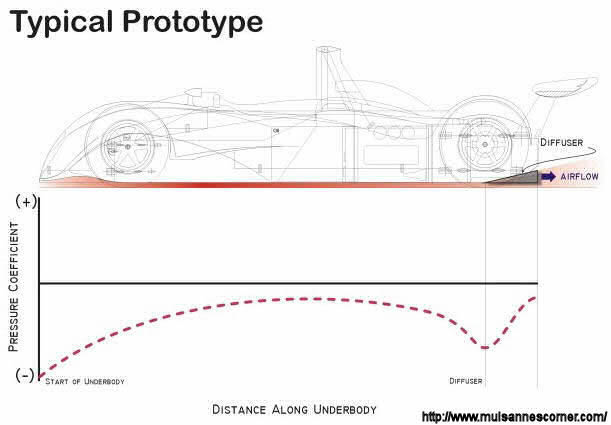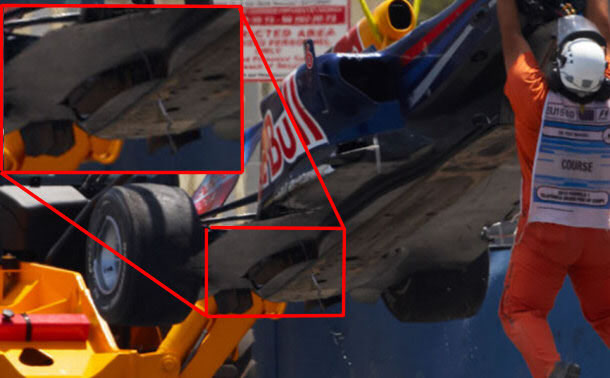Diffuser
Once the potential of using aerodynamic downforce to win races was realized, designers began experimenting with methods other than simply attaching inverted wings.
The diffuser is an area of bodywork at the rear of the car, although the term "Diffuser" is technically incorrect, it is the most popular term applied to this part of the car.
The air flowing below the car, exits through the diffuser on the rear of the car. The diffuser is usually find on each side of the central engine and gearbox fairings and is, by the rules, located behind the rear axle line. The diffuser creates nearly 50% of the cars downforce. Being so powerful the rules have progressively been tightened, making the diffuser smaller and smaller to cap cornering speeds.
Although wings and diffusers work similarly, they are based on different concepts. A diffuser serves to eject air out from the underside of the car. This pulling action increases the velocity of the air below the car, so that the more slowly moving air above the car will push the car into the ground. The suction effect is a result of Bernoulli's equation, which states that where speed of the fluid is higher, pressure must be lower. Therefore the pressure below the race car must be lower than the pressure at the outlet since the speed of the air below the racecar will be higher than the speed of the air at the outlet.
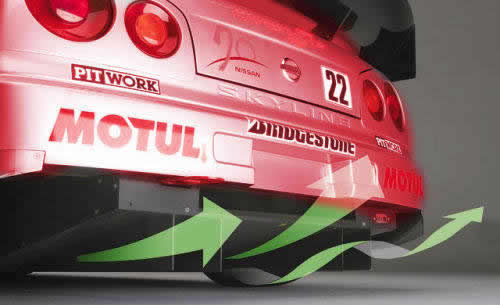
The diffuser in itself doesn't produce a reduction in pressure. The role of the diffuser is to expand the flow from underneath the car to the rear, decrease the flow's velocity from inlet of the diffuser to outlet (so that at the outlet the flow velocity is similar to the free stream velocity), inturn produce a pressure potential, which will accelerate the flow underneath the car resulting in reduced pressure and as such, a desired increased downforce generation. This pressure difference is a function of the ratio of the areas at the inlet and the outlet of the diffuser, where this area ratio is set by the diffuser angle and the vehicle ride height.
Diffuser can be considered to have "pumped-down" the underbody, inducing a component of downward force on the vehicle.
It was found during testing that the diffuser actually acted as a pump to generate downforce over the underbody flow path. This was not deemed to be the only identifiable fluidmechanical mechanism affecting the flow path around the diffuser. The three main aspects were; "ground effect‟, "underbody upsweep‟ and "diffuser pumping‟.
- "Ground Effect" plays a role when an object is used in the vicinity of a moving ground. Flow asymmetry is developed from the flow accelerating as it travels underneath the body due to ground constraint as a result the static pressure underneath the body is reduced which provides the resulting downforce.
- "Underbody Upsweep" refers to the upsweep of the diffuser at the rear. This is typically cambered and up-curved in shape, similar to the upper surface of an airfoil. Due to the direction of this curving, a resulting downward directed lift force will result during flow interaction.
- "Diffuser Pumping" refers to the increased cross-section area over the diffuser length, which can be used to increase the flow rate through diffuser because of pressure potential. As the ratio of the inlet to outlet area becomes increasingly
greater, this generates greater pressure recovery that, due to the base pressure remaining constant will increasingly depress the base pressure at the inlet. The diffuser acts to reduce the underbody pressure due to the expansion resulting in increased flow rate under the body. This increase results in further decrease in underbody pressure, which produces the "pumping down‟. This scavenging both produces a lower pressure area under the car and also acts to reduce the boundary layer. This effect is reduced with the higher underbody heights regulated since the 90’s.
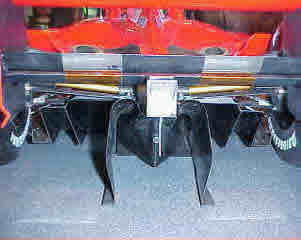 |
 |
Diffuser design before 2009 rule change |
|
Its design includes vertical fences, some of which are curved, some stepped, and some angled, but all are developed through constant tweaking and evolution in the wind tunnel. The basic job of these fences is to keep apart the many different types of air flows found at the rear end of an racing car - areas of low pressure air due to the rear wheels, and the rear wing, and the air coming under the floor. All these different air flows have different energy levels and different speeds, and their separation makes them easier to deal with.

Showing precious little of the secretive diffuser, F1 rules prohibit under-car shaping or venturis, and mandate a minimum ride height enforced by a relatively low-tech wear plank or skidblock attached underneath the car. However, there is still scope to shape the area directly under and behind the rear axle line.
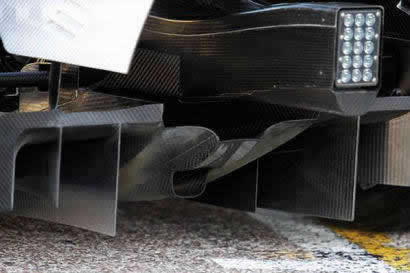
Diffuser on Mercedes GPW01 formula 1 car
Front underbody diffuser
Here we can see a typical diffuser on prototype LMP car. They have one more "diffuser" area below the nose of the car. We can see building up of the negative pressure in these two areas
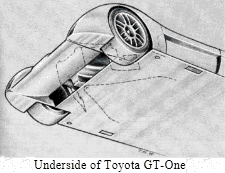
LMP cars have a flat bottom, but the front of the car can have ducts to feed the engine and such. These ducts are used also to gain a certain downforce. As you can see in the following image of a Toyota GT-One undertray, the front part of the undertray of the car is highly contoured, so that air coming under the car splits up, some of it going through to the rear of the car, but another part goes to the exits behind the front wheels. This flow, goes upward into a diffuser like compartment, where it’s pressure is reduced, thus generating downforce just ahead of the front axle. The effect is basically the same as an air splitter, but here the flow is also directed towards the sides and the splitter that marks the beginning of the flat floor.
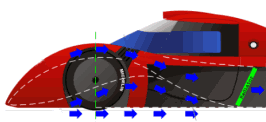
Looking at the diagram shown right, it can be seen that the car’s front is very similar to a wing in ground effect, even though looking at the vehicle there is no wing present. This design is not as effective as a "real" wing due to the redirection of flow. However, the fact the sides are relatively sealed increases the effect of the shape.
We can see there are the different ways of handling the airflow in the front of the car. Here the designers are trying to achieve the same thing as in the rear diffuser: more front end downforce by giving the air a place to expand and thus reduce pressure.
Diffusers, when good designed and working properly, can be extraordinarily important to the aerodynamics of a car. Diffuser, combined with the airfoil in the lower portion of the rear wing is employed to produce significant downforce, approximately 40 - 50% of the total car downforce. When not working properly, diffuser can mess even with the most experienced drivers.
A common problem for some badly designed diffusers is known as "diffuser stall." Sometime the problem with the diffuser stalling is linked to the bad designe of the front wing.
Every team's diffuser will stall to some degree when the rear of the car, because of high speed and higher downforce is closer to the ground, which reduces the drag and allows higher top speeds. But with that it reduces the downforce, and it is vitally important that this airflow reattaches the moment the rear of the car starts to rise. Otherwise, the braking area becomes a bit of a nightmare for the driver.
If a driver believes he has a certain grip level while taking a corner, he will take it at the highest speed possible assuming this level of grip. While braking, their car pitched forward, as you might notice when you see a car on the road braking moderately. This forward pitch lifts the rear of the car. If not designed properly, a diffuser will lose a very large percentage of its effectiveness if lifted a small amount (with the stiffness of F1 suspensions, this "small amount" is 5-10 mm). When this happens a large amount of downforce is lost, and in turn, a large amount of grip is lost. If most of the 40 - 50 percent of a driver's aerodynamic grip is lost mid-corner, it is very difficult to keep the car from twitching and you can see on onboard TV that driver start "hunting" the car with steering wheel. To sometimes add to this problem, diffuser does not reattach air flow effectively when it stalls.
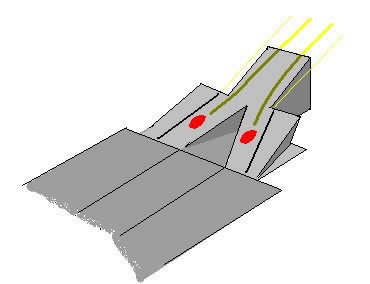
During the past there were a few ideas how to improve diffuser efficiency. Well known, but not the first try, is McLaren's try to speed up air exiting diffuser by blowing high speed exhaust gases inside diffuser area to "energise" the flow. There, speed of the airflow through the diffuser can be speed up by the high velocity gasses exiting the exhaust pipes when the engine is revving. This apparently free increase in diffuser performance was very popular in the 90s and was encouraged by bodywork restrictions preventing the exhaust pipes routing over the gearbox. The high velocity gases entrained air, energizing the thick boundary layer, and effectively powering up diffuser as it drew air under the car.
This idea was excellent but not very successful. Problem was that exhaust gases don't have constant speed. More driver press the throttle pedal, higher the speed of the exhaust gasses and better efficiency of diffuser. Less throttle, lower the speed. With lower speed of gasses, diffuser efficiency drop and driving the car with lower downforce on the back of the car is not so pleasant thing to do. The worst part of the story is that during the cornering, when you need more downforce, drivers usually need to lift a foot a bit, losing downforce in that critical point.
Slowly the practice was dropped first by routing the exhausts into less effectual positions in the diffuser and then later through the top of the sidepods using the Ferrari inspired "periscope" exhausts.
The teams need to leave a hole in the center of the diffuser to insert the outboard starter mechanism, this usually results in small cut outs in the lower ramp of the central part of the diffuser and in the Vee formed above the shadow plate. The effect of this on diffuser efficiency is minimal.
Not withstanding the 2009 downforce reduction rules, the diffuser continues to be the dominant factor in aero design. Making the most of creating low pressure under the rear of the cars bodywork is as important as ever. Year 2009 we saw teams exploit rule loopholes to create additional underbody inlets feeding larger exit areas, known as the double diffuser (read about that later in the article). Year 2010 teams have further exploited these rules for ever larger inlets and outlets. However it has again fallen to Red Bulls Adrian Newey to look at the history book and re-invent a concept that has since fallen out of favour. Last year he did this with the pull rod rear suspension and this year it has been the exhaust driven diffuser. By mounting the exhaust outlets in line with the floor, they blow through the diffuser driving greater airflow and hence creating more downforce. Already with mid season upgrades, many teams followed Red Bulls lead. Read here how Blown diffuser work.
Though Bernoulli's principle is a major source of lift or downforce in an aircraft or racing car wing, Coanda effect plays an even larger role in producing lift. To know more about interaction of Bernoulli principle and Coanda effect check my article here.
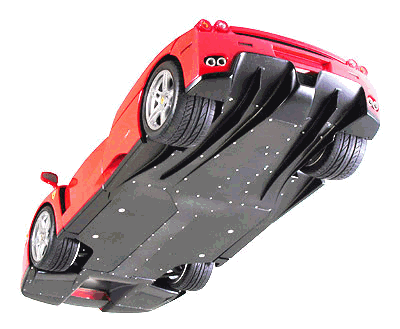
Ferrari Enzo front and rear diffuser

Rear diffuser on Ferrari F430
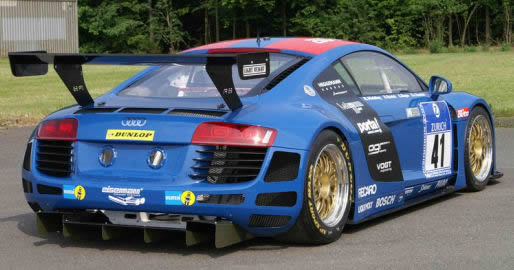
Rear diffuser on Audi R8 ready for DTM racing

Diffuser on Hyundai Genesis Coupe D1 Drift car
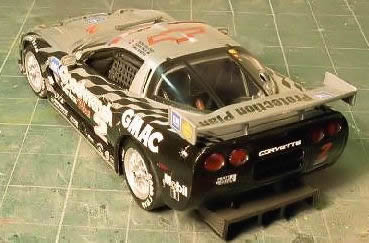
Rear diffuser on Shevrolet Corvette Can-Am
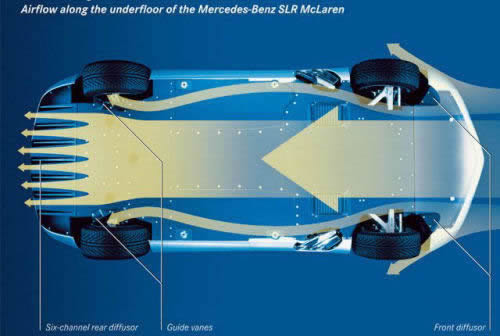
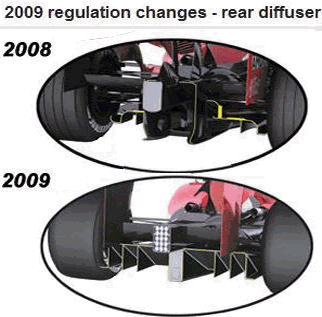
As part of the package of aero changes designed to reduce downforce for 2009, the diffuser has undergone quite complex modifications. Moves to create a more standardised shape have removed the difference in height between the central and two outer sections and all three channels are now taller - 175mm rather than 125mm. In addition, the diffuser has been moved rearwards, with its trailing edge now 350 mm behind the rear axle - previously, it was level with the rear axle.
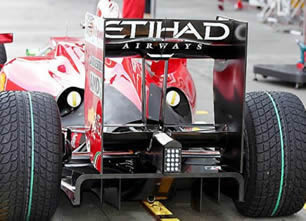 |
 |
Diffusers on Ferrari and McLaren 2009 designed by the letter of the new regulations |
|
McLaren, Ferrari, Renault and BMW Sauber have all made very literal interpretations of the revised 2009 rules regarding the rear diffuser. All of the channels are the same height and length, with no difference in height between the main central section and the side channels.
This contrasts with the designs of Toyota, Brown GP and Williams (see subsequent illustrations), which interpret the new regulations slightly differently.
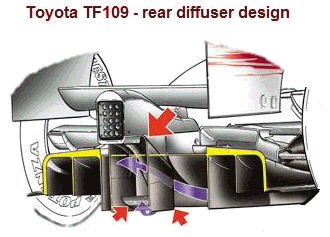 |
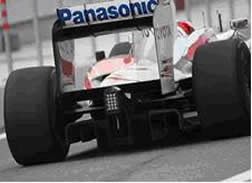 |
Toyota's diffuser makes a very interesting interpretation of the revised 2009 rules (and one that has prompted speculation regarding its legality). By exploiting regulations that allow extra bodywork within a 150mm zone in the centre of the car, the team appear to have cleverly shaped the TF109's rear crash structure (upper red arrow) so that it effectively lengthens and heightens the diffuser's central section, which also features a very low splitter at its base (lower red arrows). Because of this upper section of diffuser (extra bodywork), this type of construction was named "double decker", or "double deck diffuser".
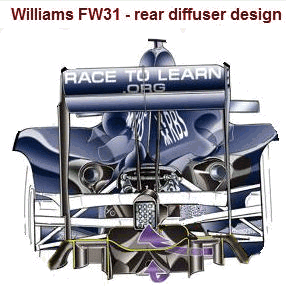 |
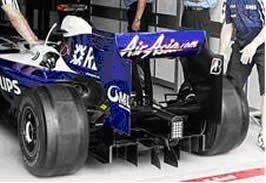 |
Like, in this time Williams engine supplier Toyota's, Williams' interpretation of the revised diffuser regulations is highly innovative. Much of the diffuser's central section is actually lower than the outer sections. However, clever shaping of the rear crash structure immediately below the rear light effectively creates a second central section (see upper arrow). In combination, the result is a central section that exceeds the 175mm height allowance that applies to the diffuser alone.
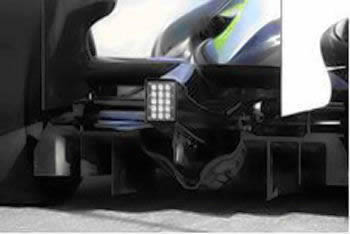
BrownGP version of diffuser
The diffusers of Brawn GP, Toyota and Williams caused a major stir during the opening two races of the season in Australia and Malesia, and Ferrari, Renault, Red Bull and BMW decided to challenge the trio at ICA (International Court of Appeal). BrownGP win first two races with Janson Buton as a winner and Rubens Barrichello as second.
The FIA International Court of Appeal (ICA) has rejected protests against the diffusers used by the Brawn, Toyota and Williams teams, after concluding that their 'double decker' designs comply with the 2009 regulations.
BMW Sauber, Ferrari, Red Bull and Renault had all questioned the legality of the diffusers, but following Tuesday's (14.04.2009) hearing in Paris, the ICA decided that race stewards in Australia and Malaysia had made the right call in declaring them legal.
Full statement from the FIA:
The FIA International Court of Appeal has decided to deny the appeals submitted against decisions numbered 16 to 24 taken by the Panel of the Stewards on 26 March at the 2009 Grand Prix of Australia and counting towards the 2009 FIA Formula One World Championship.
Based on the arguments heard and evidence before it, the Court has concluded that the Stewards were correct to find that the cars in question comply with the applicable regulations.
After a year of development, 2010 diffusers turned out as real monsters with huge downforce value. Red Bull Racing (2010 constructor champions) with their 2010 racer turned out with double diffuser and with exhaust gas blowing inside and over it. Trough the year 2010 they were almost unbeatable.
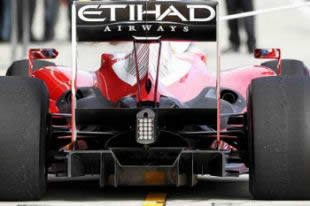
Diffuser on Ferrari f10 during 2010

Diffuser on Mercedes GPW01 - 2010
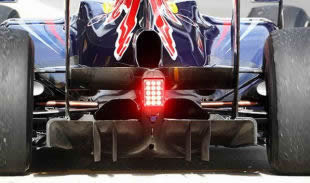
Diffuser on Red Bull Racing RB6 during 2010

